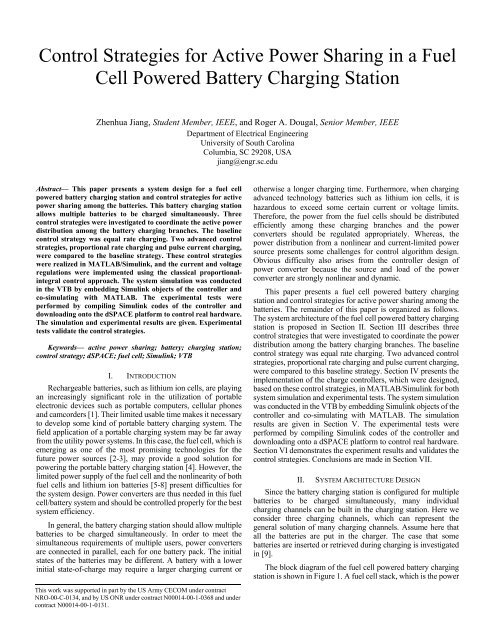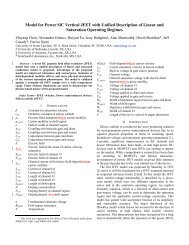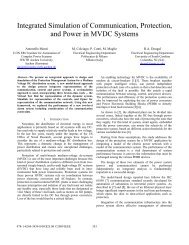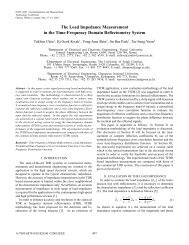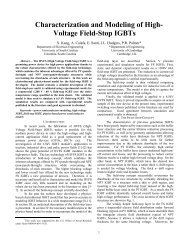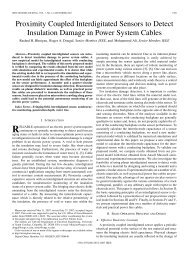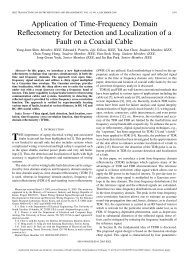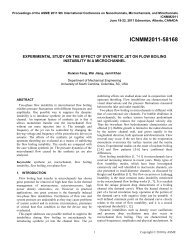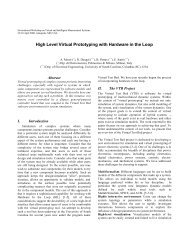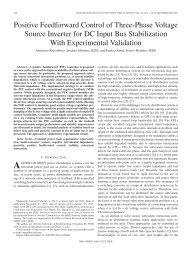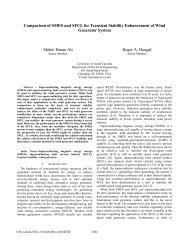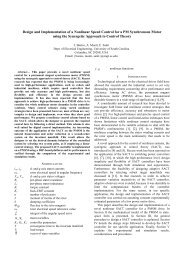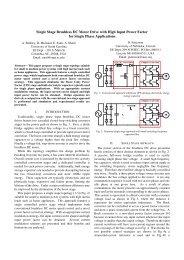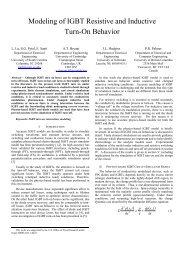Control Strategies for Active Power Sharing in a Fuel Cell Powered ...
Control Strategies for Active Power Sharing in a Fuel Cell Powered ...
Control Strategies for Active Power Sharing in a Fuel Cell Powered ...
You also want an ePaper? Increase the reach of your titles
YUMPU automatically turns print PDFs into web optimized ePapers that Google loves.
<strong>Control</strong> <strong>Strategies</strong> <strong>for</strong> <strong>Active</strong> <strong>Power</strong> <strong>Shar<strong>in</strong>g</strong> <strong>in</strong> a <strong>Fuel</strong><strong>Cell</strong> <strong>Power</strong>ed Battery Charg<strong>in</strong>g StationZhenhua Jiang, Student Member, IEEE, and Roger A. Dougal, Senior Member, IEEEDepartment of Electrical Eng<strong>in</strong>eer<strong>in</strong>gUniversity of South Carol<strong>in</strong>aColumbia, SC 29208, USAjiang@engr.sc.eduAbstract— This paper presents a system design <strong>for</strong> a fuel cellpowered battery charg<strong>in</strong>g station and control strategies <strong>for</strong> activepower shar<strong>in</strong>g among the batteries. This battery charg<strong>in</strong>g stationallows multiple batteries to be charged simultaneously. Threecontrol strategies were <strong>in</strong>vestigated to coord<strong>in</strong>ate the active powerdistribution among the battery charg<strong>in</strong>g branches. The basel<strong>in</strong>econtrol strategy was equal rate charg<strong>in</strong>g. Two advanced controlstrategies, proportional rate charg<strong>in</strong>g and pulse current charg<strong>in</strong>g,were compared to the basel<strong>in</strong>e strategy. These control strategieswere realized <strong>in</strong> MATLAB/Simul<strong>in</strong>k, and the current and voltageregulations were implemented us<strong>in</strong>g the classical proportional<strong>in</strong>tegralcontrol approach. The system simulation was conducted<strong>in</strong> the VTB by embedd<strong>in</strong>g Simul<strong>in</strong>k objects of the controller andco-simulat<strong>in</strong>g with MATLAB. The experimental tests wereper<strong>for</strong>med by compil<strong>in</strong>g Simul<strong>in</strong>k codes of the controller anddownload<strong>in</strong>g onto the dSPACE plat<strong>for</strong>m to control real hardware.The simulation and experimental results are given. Experimentaltests validate the control strategies.Keywords— active power shar<strong>in</strong>g; battery; charg<strong>in</strong>g station;control strategy; dSPACE; fuel cell; Simul<strong>in</strong>k; VTBI. INTRODUCTIONRechargeable batteries, such as lithium ion cells, are play<strong>in</strong>gan <strong>in</strong>creas<strong>in</strong>gly significant role <strong>in</strong> the utilization of portableelectronic devices such as portable computers, cellular phonesand camcorders [1]. Their limited usable time makes it necessaryto develop some k<strong>in</strong>d of portable battery charg<strong>in</strong>g system. Thefield application of a portable charg<strong>in</strong>g system may be far awayfrom the utility power systems. In this case, the fuel cell, which isemerg<strong>in</strong>g as one of the most promis<strong>in</strong>g technologies <strong>for</strong> thefuture power sources [2-3], may provide a good solution <strong>for</strong>power<strong>in</strong>g the portable battery charg<strong>in</strong>g station [4]. However, thelimited power supply of the fuel cell and the nonl<strong>in</strong>earity of bothfuel cells and lithium ion batteries [5-8] present difficulties <strong>for</strong>the system design. <strong>Power</strong> converters are thus needed <strong>in</strong> this fuelcell/battery system and should be controlled properly <strong>for</strong> the bestsystem efficiency.In general, the battery charg<strong>in</strong>g station should allow multiplebatteries to be charged simultaneously. In order to meet thesimultaneous requirements of multiple users, power convertersare connected <strong>in</strong> parallel, each <strong>for</strong> one battery pack. The <strong>in</strong>itialstates of the batteries may be different. A battery with a lower<strong>in</strong>itial state-of-charge may require a larger charg<strong>in</strong>g current orotherwise a longer charg<strong>in</strong>g time. Furthermore, when charg<strong>in</strong>gadvanced technology batteries such as lithium ion cells, it ishazardous to exceed some certa<strong>in</strong> current or voltage limits.There<strong>for</strong>e, the power from the fuel cells should be distributedefficiently among these charg<strong>in</strong>g branches and the powerconverters should be regulated appropriately. Whereas, thepower distribution from a nonl<strong>in</strong>ear and current-limited powersource presents some challenges <strong>for</strong> control algorithm design.Obvious difficulty also arises from the controller design ofpower converter because the source and load of the powerconverter are strongly nonl<strong>in</strong>ear and dynamic.This paper presents a fuel cell powered battery charg<strong>in</strong>gstation and control strategies <strong>for</strong> active power shar<strong>in</strong>g among thebatteries. The rema<strong>in</strong>der of this paper is organized as follows.The system architecture of the fuel cell powered battery charg<strong>in</strong>gstation is proposed <strong>in</strong> Section II. Section III describes threecontrol strategies that were <strong>in</strong>vestigated to coord<strong>in</strong>ate the powerdistribution among the battery charg<strong>in</strong>g branches. The basel<strong>in</strong>econtrol strategy was equal rate charg<strong>in</strong>g. Two advanced controlstrategies, proportional rate charg<strong>in</strong>g and pulse current charg<strong>in</strong>g,were compared to this basel<strong>in</strong>e strategy. Section IV presents theimplementation of the charge controllers, which were designed,based on these control strategies, <strong>in</strong> MATLAB/Simul<strong>in</strong>k <strong>for</strong> bothsystem simulation and experimental tests. The system simulationwas conducted <strong>in</strong> the VTB by embedd<strong>in</strong>g Simul<strong>in</strong>k objects of thecontroller and co-simulat<strong>in</strong>g with MATLAB. The simulationresults are given <strong>in</strong> Section V. The experimental tests wereper<strong>for</strong>med by compil<strong>in</strong>g Simul<strong>in</strong>k codes of the controller anddownload<strong>in</strong>g onto a dSPACE plat<strong>for</strong>m to control real hardware.Section VI demonstrates the experiment results and validates thecontrol strategies. Conclusions are made <strong>in</strong> Section VII.II.SYSTEM ARCHITECTURE DESIGNS<strong>in</strong>ce the battery charg<strong>in</strong>g station is configured <strong>for</strong> multiplebatteries to be charged simultaneously, many <strong>in</strong>dividualcharg<strong>in</strong>g channels can be built <strong>in</strong> the charg<strong>in</strong>g station. Here weconsider three charg<strong>in</strong>g channels, which can represent thegeneral solution of many charg<strong>in</strong>g channels. Assume here thatall the batteries are put <strong>in</strong> the charger. The case that somebatteries are <strong>in</strong>serted or retrieved dur<strong>in</strong>g charg<strong>in</strong>g is <strong>in</strong>vestigated<strong>in</strong> [9].The block diagram of the fuel cell powered battery charg<strong>in</strong>gstation is shown <strong>in</strong> Figure 1. A fuel cell stack, which is the powerThis work was supported <strong>in</strong> part by the US Army CECOM under contractNRO-00-C-0134, and by US ONR under contract N00014-00-1-0368 and undercontract N00014-00-1-0131.
generation system, is used to charge up to three lithium ionbattery packs through three separate buck converters. Eachbattery conta<strong>in</strong>s four series-connected cells. The buck converterscontrol the charg<strong>in</strong>g current and voltage supplied to each battery,and allocate the available power among the batteries accord<strong>in</strong>gto one of several control strategies that are described here.Figure 1. Block diagram of the system architecture.As shown <strong>in</strong> Figure 1, three buck converters are connected <strong>in</strong>parallel to a s<strong>in</strong>gle fuel cell power source. The power availablefrom the fuel cell is distributed among the three batteries,accord<strong>in</strong>g to (1).P fc P1 + P2+ P3= (1)where P 1 , P 2 , and P 3 are the power to three charg<strong>in</strong>g channelsrespectively, and P fc is the power from the fuel cell.In practice, the power distribution among the batteries isrealized by regulat<strong>in</strong>g the charg<strong>in</strong>g currents of the batteries. Thefollow<strong>in</strong>g equation relates the current from the fuel cell to threecharg<strong>in</strong>g currents, assum<strong>in</strong>g no power loss <strong>in</strong> these powerconverters.I fc d1I1+ d2I2 + d3I3= (2)where I 1 , I 2 , and I 3 are the charg<strong>in</strong>g currents to three batteriesrespectively, I fc is the current from the fuel cell, and d 1 , d 2 and d 3are the duty cycles of three buck converters, respectively, andthey have values between 0 and 1.The sum of the right hand side <strong>in</strong> (2) should be less than themaximum current available from the fuel cell. Consider<strong>in</strong>g thatvariations of the voltages of the fuel cells and batteries are notlarge, the duty cycle will vary with<strong>in</strong> a limited small range,which means, <strong>for</strong> <strong>in</strong>stance, values of d 1 , d 2 and d 3 are between0.70 and 0.75. Based on this assumption, we can take thefollow<strong>in</strong>g expression as a criterion <strong>for</strong> power distribution amongthe batteries.I1 I2+ I3≤ Ilim+ (3)where I lim is a preset limit <strong>for</strong> the total charg<strong>in</strong>g current that canbe estimated accord<strong>in</strong>g to the maximum current available fromthe fuel cell and the average duty cycle of power converters.Equation (3) gives a basic requirement <strong>for</strong> the design of controlstrategies <strong>for</strong> active power shar<strong>in</strong>g.III. CONTROL STRATEGIES FOR ACTIVE POWER SHARINGDifferent users may have different requirements <strong>for</strong> charg<strong>in</strong>gtheir batteries. Some people may require that the batteries befully charged with<strong>in</strong> the shortest period of time, while otherswish to maximize the cycle life of their batteries, or m<strong>in</strong>imize thefuel consumption dur<strong>in</strong>g the charg<strong>in</strong>g process. This paper aimsto discover the appropriate control schemes <strong>for</strong> m<strong>in</strong>imiz<strong>in</strong>g thecharg<strong>in</strong>g time. Three control strategies were <strong>in</strong>vestigated tocoord<strong>in</strong>ate the power distribution among the battery branchesand they are equal rate charg<strong>in</strong>g, proportional rate charg<strong>in</strong>g andpulse current charg<strong>in</strong>g. The first one is the basel<strong>in</strong>e controlstrategy, and the other two are compared with it.Among these control strategies <strong>for</strong> active power shar<strong>in</strong>g, twok<strong>in</strong>ds of charg<strong>in</strong>g protocols may be used. They are constantcurrent-constant voltage (CC-CV) charg<strong>in</strong>g protocol and pulsecurrent charg<strong>in</strong>g protocol. CC-CV charg<strong>in</strong>g protocol can help toprotect the battery from overcharg<strong>in</strong>g. Under this protocol, thebattery is charged to an end potential us<strong>in</strong>g a constant current.The potential is then held constant after this potential is reached,and the charg<strong>in</strong>g current gradually decreases. The charg<strong>in</strong>gprocess term<strong>in</strong>ates when the current reaches a preset small valuedur<strong>in</strong>g the constant voltage mode. Under pulse current charg<strong>in</strong>gprotocol, a pulse current with a period of T and pulse-duration ofTon is applied to the battery. Pulse current charg<strong>in</strong>g protocol hasbeen shown to enhance charg<strong>in</strong>g rate capability and to preventthe <strong>in</strong>crease of <strong>in</strong>ternal impedance of the battery, thus reduc<strong>in</strong>gthe total charg<strong>in</strong>g time [8].A straight<strong>for</strong>ward control strategy <strong>for</strong> charg<strong>in</strong>g all of thebatteries simultaneously us<strong>in</strong>g constant currents is to equallydistribute the charg<strong>in</strong>g current among them. Due to differences<strong>in</strong> the <strong>in</strong>itial states of the batteries, some batteries may reach thereference voltage earlier than the others may. When one batteryreaches the voltage limit, its voltage will be held constant and itscharg<strong>in</strong>g current will taper. The rest of the total available currentwill be distributed equally between the other two batteries. Thenthe same scheme is followed <strong>for</strong> the rema<strong>in</strong><strong>in</strong>g batteries until allof the batteries are held <strong>in</strong> the constant voltage mode. Thisstrategy, called equal rate charg<strong>in</strong>g, is the basel<strong>in</strong>e controlstrategy <strong>for</strong> active power shar<strong>in</strong>g. This control strategy isillustrated <strong>in</strong> Figure 2-a, and it can be easily implemented on thehardware. The charg<strong>in</strong>g time will be as long as it takes to chargethe most depleted battery, and, <strong>in</strong> particular, it may be muchlonger than the charg<strong>in</strong>g time <strong>for</strong> the less depleted battery tobecome fully charged when the <strong>in</strong>itial states of charge of thebatteries are widely disparate.A more time-efficient control strategy can take <strong>in</strong>to accountthe fact that the charge that any battery will need to become fullycharged is proportional to its depth of discharge where the depthof discharge is def<strong>in</strong>ed as unity m<strong>in</strong>us the state of charge of thisbattery. As implied <strong>in</strong> the previous control strategy, if cont<strong>in</strong>uouscurrents of the same magnitude are applied to charge differentbatteries, the charg<strong>in</strong>g times will be approximately proportional2
to the depth of discharge (neglect<strong>in</strong>g nonl<strong>in</strong>earity of thebatteries). On the other hand, if we want all the batteries tobecome fully charged dur<strong>in</strong>g the same period of time, thecharg<strong>in</strong>g current of each battery can be made proportional to thefraction of the depth of discharge of this battery, which can becalculated accord<strong>in</strong>g to (4)1−SOCiIi = Ilim ⋅, i = 1,2,3 (4)3∑ (1 − SOC )i=1where I i is the charg<strong>in</strong>g current of the ith battery, I lim is the totalavailable charg<strong>in</strong>g current, and SOC i is the <strong>in</strong>itial state-of-chargeof the ith battery.This control strategy is called proportional rate charg<strong>in</strong>g,which is shown <strong>in</strong> Figure 2-b. Under this strategy, the batteriesmay become fully charged almost simultaneously. However, it isdifficult to estimate the state of charge. For lithium ion batteries,an approximate relationship between the state-of-charge andopen circuit voltage can be found when the state-of-charge is notwith<strong>in</strong> the extreme range, i.e., if the state-of-charge is between0.1 and 0.9. When the state of charge is greater than 0.9, thebattery charger is usually work<strong>in</strong>g under constant voltage mode.The charg<strong>in</strong>g current is not determ<strong>in</strong>ed by the charge controlleritself, but by the <strong>in</strong>ternal potential and term<strong>in</strong>al voltage of thebattery. It is not necessary to estimate the state-of-charge s<strong>in</strong>cethe <strong>in</strong><strong>for</strong>mation about state-of-charge is useful only when thecharger works under current regulation mode. When the state ofcharge is less than 0.1, the estimation is cut off to 0.1. In this case,the estimated value <strong>for</strong> depth of discharge is 0.9, and the fractionof the depth of discharge is very close to that us<strong>in</strong>g a moreaccurate value of the state of charge. There<strong>for</strong>e, the <strong>in</strong>itialstate-of-charge can be estimated by measur<strong>in</strong>g the battery opencircuit voltage and l<strong>in</strong>early fitt<strong>in</strong>g the open circuit voltage to thestate-of-charge. As we will show, even this simpleapproximation is sufficient <strong>for</strong> def<strong>in</strong><strong>in</strong>g the current shar<strong>in</strong>g.In addition to DC charg<strong>in</strong>g, the third control strategy is pulsecurrent charg<strong>in</strong>g which uses the pulse current charg<strong>in</strong>g protocolwhile the previous two control strategies use CC-CV charg<strong>in</strong>gprotocol. With this strategy, three pulse currents with the sameperiod of T and different pulse-durations are applied to threebatteries alternatively. The sum of the pulse-durations of thethree pulse currents is equal to the period. This control strategy isillustrated <strong>in</strong> Figure 2-c. A strategy similar to proportional ratecharg<strong>in</strong>g can be def<strong>in</strong>ed <strong>for</strong> pulse current charg<strong>in</strong>g by mak<strong>in</strong>g theduty cycle of each pulse current proportional to the fraction ofthe depth of discharge of this battery. This duty cycle can beestimated accord<strong>in</strong>g to the follow<strong>in</strong>g equation.i1−SOCidi =, i = 1,2,3(5)3∑ (1 − SOCi)i=1where d i is the duty cycle of the charg<strong>in</strong>g current of the ithbattery.Under this strategy, the charg<strong>in</strong>g current can be relativelylarge because only one battery draws this current at any time.There<strong>for</strong>e, it can be the limit<strong>in</strong>g current available from the fuelcell as long as it does not exceed the current limit <strong>for</strong> any battery.With this strategy, it is also possible <strong>for</strong> all the batteries tobecome fully charged almost simultaneously. Nevertheless, thedisadvantage is that the control algorithm to implement thisstrategy on the hardware is more complicated compared to DCcharg<strong>in</strong>g because the output currents of three power converterschange frequently result<strong>in</strong>g <strong>in</strong> frequent changes <strong>in</strong> the voltagesof the batteries, an undesired fluctuation <strong>in</strong> the output voltage ofthe fuel cell, and high dynamics of the system.(a) Equal rate charg<strong>in</strong>g(b)Proportional rate charg<strong>in</strong>g(c) Pulse current charg<strong>in</strong>gFigure 2. Illustration of three control strategies <strong>for</strong> active power shar<strong>in</strong>g.The detail of implement<strong>in</strong>g the three control strategies asshown <strong>in</strong> Figure 2 is expla<strong>in</strong>ed as follows. For the convenienceof demonstration, assume that <strong>in</strong>itially V1>V2>V3 where V 1 , V 2 ,V 3 are the voltages of three batteries respectively. In thesestrategies, I lim is the limit of the total charg<strong>in</strong>g current; V ref isbattery end potential, which is usually 4.2V <strong>for</strong> each cell; and I 1 ,I 2 , I 3 are the charg<strong>in</strong>g currents of three batteries respectively.(Here we assume that the maximum current available from thefuel cell, I lim , is less than the sum of the maximum safe charg<strong>in</strong>gcurrents <strong>for</strong> all of the batteries.)A. Strategy 1: Equal rate charg<strong>in</strong>g (Basel<strong>in</strong>e)• If V 1
• If V 2 = V ref , I 2 is taper<strong>in</strong>g, and I ref,3= I lim - I 1 - I 2• If V 3 = V ref , I 3 is taper<strong>in</strong>g• If I i
V. SIMULATION RESULTSIn order to compare the per<strong>for</strong>mances of three controlstrategies <strong>for</strong> active power shar<strong>in</strong>g, simulation studies were firstconducted <strong>in</strong> the VTB [10]. Figure 4 shows the VTB schematicview of the system shown <strong>in</strong> Figure 1. The power source is a25-cell PEM fuel cell stack. Each battery is a 4X1 (series byparallel connections) array of lithium ion cells. The capacity ofeach battery is 1500mAh. The <strong>in</strong>itial states of charge of thebatteries are 0.7, 0.5, and 0.3, respectively. Each power converteris implemented by a switch<strong>in</strong>g-average buck converter model <strong>in</strong>series with a low pass filter.Figure 4. Schematic view of the fuel cell powered battery charg<strong>in</strong>g station.The controller is implemented <strong>in</strong> the Simul<strong>in</strong>k models asshown <strong>in</strong> Figure 3. It is embedded <strong>in</strong> VTB through aVTB-Simul<strong>in</strong>k <strong>in</strong>terface and it can co-simulate with VTB<strong>in</strong>teractively. The charg<strong>in</strong>g currents and battery voltages aresensed and fed to the controller. The controller outputs three dutycycles to the power converters and three commands <strong>for</strong> theswitches. The proportional and <strong>in</strong>tegral ga<strong>in</strong>s <strong>for</strong> currentregulation are 0.05 and 0.002 respectively. The proportional and<strong>in</strong>tegral ga<strong>in</strong>s <strong>for</strong> voltage regulation are 0.01 and 0.001respectively. In the studied DC charg<strong>in</strong>g strategies, the sum ofthe total available charg<strong>in</strong>g currents is limited to 2 Amperes.While the reference charg<strong>in</strong>g currents are set 0.66A <strong>for</strong> all of thebatteries under the basel<strong>in</strong>e strategy, they are 0.38A, 0.66A, and0.96A, respectively, under proportional rate charg<strong>in</strong>g strategy.The limit of the charg<strong>in</strong>g currents is 1.5A <strong>for</strong> pulse currentcharg<strong>in</strong>g strategy tak<strong>in</strong>g the safe charg<strong>in</strong>g current of the batteries<strong>in</strong>to consideration. The duty cycles of the charg<strong>in</strong>g currents are20%, 33.3% and 46.7%, respectively, <strong>for</strong> three batteries. Thecharg<strong>in</strong>g process stops when the battery voltage dur<strong>in</strong>g thelow-pulse-duration reaches the reference voltage.This system is simulated with the three different charg<strong>in</strong>gstrategies <strong>for</strong> 2 hours (7200 seconds). The simulated charg<strong>in</strong>gcurrents and states of charge of the batteries under three charg<strong>in</strong>gstrategies are shown <strong>in</strong> Figures 5-a, b, 5-c, d, and 5-e, frespectively.Obviously, with the basel<strong>in</strong>e strategy, the state-of-charge ofthe battery with highest <strong>in</strong>itial voltage <strong>in</strong>creases more rapidlythan the others. It is seen from Figures 5-d and 5-f that, withproportional rate charg<strong>in</strong>g strategy and pulse current charg<strong>in</strong>gstrategy, the state-of-charge of the battery with lowest <strong>in</strong>itialvoltage <strong>in</strong>creases more rapidly than the others. There<strong>for</strong>e, thesetwo strategies can help reduce the total charg<strong>in</strong>g time. From thesimulation results, the follow<strong>in</strong>g conclusions can be drawn <strong>for</strong>the three control strategies.1) While the battery with the highest <strong>in</strong>itial state-of-chargebecomes full fastest with the basel<strong>in</strong>e charg<strong>in</strong>g strategy, the totaltime to charge all the batteries is the longest if there are apparentdifferences <strong>in</strong> the <strong>in</strong>itial state-of-charge. It is seen from Figure5-a that it takes about 4050 and 6900 seconds <strong>for</strong> the first and lastbatteries, respectively, to become full.2) Compared with the basel<strong>in</strong>e strategy, the total charg<strong>in</strong>gtime with proportional rate charg<strong>in</strong>g strategy is shorter. It isshown <strong>in</strong> Figure 5-c that it takes about 4050 and 6900 seconds<strong>for</strong> the first and last batteries, respectively, to become full.3) Among three control strategies, pulse current charg<strong>in</strong>gstrategy achieves the shortest total charg<strong>in</strong>g time because the<strong>in</strong>dividual charg<strong>in</strong>g current is relatively large. It takes about5400 seconds <strong>for</strong> all the batteries to become full, about 500seconds earlier than the basel<strong>in</strong>e strategy and 1500 secondsfaster than proportional rate charg<strong>in</strong>g strategy.4) It can be seen that all of the batteries can become fullycharged almost simultaneously when they are charged with anappropriate set of proportional-rate cont<strong>in</strong>uous currents or pulsecurrents. There<strong>for</strong>e, it is true that proportional rate charg<strong>in</strong>gstrategy and pulse current strategy are effective <strong>for</strong> charg<strong>in</strong>g thebatteries.From above, we can see that proportional rate charg<strong>in</strong>gstrategy is superior to the basel<strong>in</strong>e strategy <strong>in</strong> respect to reduc<strong>in</strong>gthe total charg<strong>in</strong>g time. In order to give a wider view of thisadvantage, the simulation is run five times each at n<strong>in</strong>e discrete<strong>in</strong>itial states to compare the total charg<strong>in</strong>g time with these twostrategies under different <strong>in</strong>itial conditions. Figure 6 shows theplots of the total charg<strong>in</strong>g time aga<strong>in</strong>st the averagestate-of-charge of three batteries under equal rate charg<strong>in</strong>gstrategy and proportional rate charg<strong>in</strong>g strategy <strong>for</strong> different<strong>in</strong>itial battery states. The states of charge of the three batterieshave equal difference and the average state-of-charge is theiralgebraic mean value. It is seen from Figure 6 that the totalcharg<strong>in</strong>g time decreases with the average state-of-charge <strong>in</strong> spiteof the control strategy or <strong>in</strong>itial states of the batteries. For every<strong>in</strong>itial average state-of-charge, the total charg<strong>in</strong>g time withproportional rate charg<strong>in</strong>g strategy is shorter than that with equalrate charg<strong>in</strong>g strategy. The total charg<strong>in</strong>g time <strong>in</strong>creases with thedifference <strong>in</strong> the <strong>in</strong>itial state-of-charge with both strategies. Thereason <strong>for</strong> proportional rate charg<strong>in</strong>g strategy is that the error ofthe <strong>in</strong>itial state-of-charge estimation is bigger when theirdifferences <strong>in</strong>crease. For equal rate charg<strong>in</strong>g strategy, this isbecause it takes a longer time to charge the most depleted batterywhen the difference is bigger. When all batteries have theidentical <strong>in</strong>itial state-of-charge, both strategies have the sameeffect on the current shar<strong>in</strong>g and the total charg<strong>in</strong>g time isidentical.5
(a) charg<strong>in</strong>g currents(b) states of charge(c) charg<strong>in</strong>g currents(d) states of charge(e) charg<strong>in</strong>g currents(f) states of chargeFigure 5. Charg<strong>in</strong>g currents and states of charge under three control strategies: (from top to bottom) equal rate charg<strong>in</strong>g, proportional rate charg<strong>in</strong>g, and pulsecurrent charg<strong>in</strong>g.6
#3 were 0.75, 0.83, and 0.92 respectively. Their <strong>in</strong>itial opencircuit voltages were 15.9V, 16.1V, and 16.4V, respectively.The <strong>in</strong>itial state-of-charge of the battery was measured us<strong>in</strong>g thefollow<strong>in</strong>g approach. Each battery was discharged to fulldepletion. A constant current was then applied to charge thebattery until it was full and the total charg<strong>in</strong>g time was recorded.After fully deplet<strong>in</strong>g this battery, charg<strong>in</strong>g this battery with thesame current <strong>for</strong> a proportion (equal to the <strong>in</strong>itial state-of-charge<strong>in</strong> magnitude) of the total charg<strong>in</strong>g time could obta<strong>in</strong> a desired<strong>in</strong>itial state-of- charge.Figure 6. Plots of the total charg<strong>in</strong>g time aga<strong>in</strong>st the average state-of-chargeof three batteries with equal rate charg<strong>in</strong>g strategy and proportional ratecharg<strong>in</strong>g strategy under different <strong>in</strong>itial battery states: 1. with proportional ratecharg<strong>in</strong>g strategy and a maximum <strong>in</strong>itial state-of-charge differennce of 20%, 2.with proportional rate charg<strong>in</strong>g strategy and a maximum <strong>in</strong>itial state-of-chargedifferennce of 40%, 3. with equal rate charg<strong>in</strong>g strategy and a maximum <strong>in</strong>itialstate-of-charge differennce of 20%, 4. with equal rate charg<strong>in</strong>g strategy and amaximum <strong>in</strong>itial state-of-charge differennce of 40%, 5. with either of thecharg<strong>in</strong>g strategies and the same <strong>in</strong>itial state-of-charge.VI. EXPERIMENT VALIDATIONNext, these control strategies were validated with realhardware. A prototype of the fuel cell powered battery charg<strong>in</strong>gstation was built us<strong>in</strong>g an H-<strong>Power</strong> D35 PEM fuel cell stack asthe power source. This stack has a nom<strong>in</strong>al power capacity of35W and nom<strong>in</strong>al 24V open circuit voltage. Three 4-cellPanasonic lithium ion batteries were used. The nom<strong>in</strong>al capacityof each battery is 1500mAh. Three buck converters were builton one s<strong>in</strong>gle board to distribute the charg<strong>in</strong>g current. The blockdiagram of the experiment environment is shown <strong>in</strong> Figure 7.The charg<strong>in</strong>g algorithms implement<strong>in</strong>g the control strategiesreside on a general-purpose dSPACE real-time controller board,which also houses the hardware <strong>in</strong>terface consist<strong>in</strong>g ofmulti-channel A/D and D/A converters. The charg<strong>in</strong>g controlalgorithms are designed and implemented us<strong>in</strong>g MATLAB/Simul<strong>in</strong>k and the codes are then compiled and dropped onto adSPACE DS1103 PPC controller board to control the realhardware. The charg<strong>in</strong>g currents and battery voltages aremonitored and <strong>in</strong>put to the dSPACE controller board throughthe A/D converters mounted on it. The power source bus voltageis also an <strong>in</strong>put variable <strong>for</strong> monitor<strong>in</strong>g purpose. The real-timecontroller provides the switch duty commands to each buckconverter. The circuit protection function is also implementedwith<strong>in</strong> the software.Tests were conducted us<strong>in</strong>g the proportional rate charg<strong>in</strong>gstrategy. In order to ensure that each charg<strong>in</strong>g current wouldnever exceed the safe maximum charg<strong>in</strong>g current (that is800mA <strong>for</strong> the batteries used <strong>in</strong> the experiment), the totalcharg<strong>in</strong>g current was scaled down by half to 1.0 Ampere. For theconvenience of demonstration, three batteries were numbered#1, #2, and #3. The <strong>in</strong>itial state-of-charge of batteries #1 throughFigure 7.Block diagram of experiment environment.Accord<strong>in</strong>g to the <strong>in</strong>itial states-of-charge of the batteries, thecontroller selected the charg<strong>in</strong>g currents as 0.5A, 0.35A, and0.15A <strong>for</strong> batteries #1 through #3 respectively. The measuredbattery voltages and charg<strong>in</strong>g currents are shown <strong>in</strong> Figure 8,where the simulated voltages and currents are also plotted.Small differences <strong>in</strong> the voltages between simulation results andexperiment data were observed and this was due to the fact thatmore detailed transients were not characterized <strong>in</strong> the batterymodel. The ripples <strong>in</strong> the currents were a little large and this wasbecause current transducers with low resolution were used tomeasure the charg<strong>in</strong>g currents. Although then, it can be said thatthe simulation results matched experiment data very well. FromFigure 8, it is seen that the battery with the lowest <strong>in</strong>itial voltage(and thus the least <strong>in</strong>itial charge) was charged with the highestcurrent, and its voltage <strong>in</strong>creased more rapidly than the others.This was also predicted by the simulation. This feature impliesthat proportional rate charg<strong>in</strong>g strategy can help to reduce thetotal charg<strong>in</strong>g time. After a little while of charg<strong>in</strong>g, the voltagesof batteries #1 and #2 exceeded the voltage of the third battery.The voltages of these two batteries reached the reference voltagealmost simultaneously, and then their currents tapered. Whenthese currents approached to 0.15A, the third battery reached thereference voltage and its current tapered. It is also seen that all ofthree batteries became fully charged almost simultaneously.7
Voltage(V)16.816.716.616.5Simulation Result (#1)Simulation Result (#2)Simulation Result (#3)Experiment Datawere used <strong>for</strong> both system simulation and experimental runtime.Simulation results show that, with equal rate charg<strong>in</strong>g strategy,the battery with the highest <strong>in</strong>itial state-of-charge becomes fullfastest but the total charg<strong>in</strong>g time is longest. Proportional ratecharg<strong>in</strong>g strategy is superior to equal rate charg<strong>in</strong>g strategy <strong>in</strong>respect to the total charg<strong>in</strong>g time. The total charg<strong>in</strong>g time<strong>in</strong>creases with the difference <strong>in</strong> the <strong>in</strong>itial state-of-charge of eachbattery with both strategies. The total charg<strong>in</strong>g time is m<strong>in</strong>imumwith pulse current charg<strong>in</strong>g strategy. It is possible <strong>for</strong> all thebatteries to become full almost simultaneously when they arecharged with appropriate proportional constant currents or pulsecurrents. Experimental tests validated these control strategiesand simulation results.16.40 1000 2000 3000 4000 5000 6000Time(s)(a) From top to down (on the left vertical axis): voltages of batteries #3, #2, and#1Current(A)0.50.40.30.20.1Simulation Result (#1)Simulation Result (#2)Simulation Result (#3)Experiment Data00 1000 2000 3000 4000 5000 6000Time(s)(b) From top to down: charg<strong>in</strong>g currents <strong>for</strong> batteries #1, #2, and #3Figure 8. The measured battery voltage voltages and charg<strong>in</strong>g currents:(a) voltages, (b) currents.VII. CONCLUSIONSThis paper presents an effective system design <strong>for</strong> a fuel cellpowered battery charg<strong>in</strong>g station. Three control strategiescoord<strong>in</strong>at<strong>in</strong>g active power shar<strong>in</strong>g among multiple batterybranches were developed and compared. TheMATLAB/Simul<strong>in</strong>k def<strong>in</strong>itions of the battery charge controllersACKNOWLEDGMENTThis work was supported <strong>in</strong> part by the US Army CECOMunder contract NRO-00-C-0134, and by US ONR under contractN00014-00-1-0368 and under contract N00014-00-1-0131.REFERENCES[1] R. J .Brodd, “Overview: rechargeable battery systems”, WESCON'93.Conf. Record, pp. 206 –209, 1993.[2] B. Rohland, J. Nitsch, and H. Wendt, “Hydrogen and fuel cells ¯¯ theclean energy system”, Journal of <strong>Power</strong> Sources, Vol. 37, No. 1-2, pp.271-277, January 1992.[3] A. He<strong>in</strong>zel, C. Hebl<strong>in</strong>g, M. Müller, M. Zedda and C. Müller, “<strong>Fuel</strong> cells<strong>for</strong> low power applications”, Journal of <strong>Power</strong> Sources, Vol. 105, No. 2,pp. 148-153, March 2002.[4] Z. Jiang and R. Dougal, “<strong>Control</strong> design and test<strong>in</strong>g of a novelfuel-cell-powered battery-charg<strong>in</strong>g station”, Proceed<strong>in</strong>g of IEEE Apllied<strong>Power</strong> Electronic Conference, Miami, Florida, Feb. 10-14, 2003.[5] M. M. Bernardi, and M. W. Verbrugge, “A mathematical model of thesolid-polymer-electrolyte fuel cell”, Journal of Electrochemical Society,Vol. 139, No. 9, pp. 2477-2491, September 1992.[6] J. Kim, S. M. Lee, and S. Sr<strong>in</strong>ivasan, “Model<strong>in</strong>g of proton exchangemembrane fuel cell per<strong>for</strong>mance with an empirical equation”, Journal ofElectrochemical Society, Vol. 142, No. 8, pp. 2670-2674, August 1995.[7] L. Song and J. W. Evans, “Electrochemical-thermal model of lithiumpolymer batteries”, Journal of Electrochemical Society, Vol. 147, No. 6,pp. 2086-2095, 2000.[8] J. Li, E. Murphy, J. W<strong>in</strong>nick and P. A. Kohl, “The effects of pulsecharg<strong>in</strong>g on cycl<strong>in</strong>g characteristics of commercial lithium-ion batteries”,Journal of <strong>Power</strong> Sources, Vol. 102, No. 1-2, pp.302-309, December2001.[9] Z. Jiang and R. Dougal, “Design, rapid prototyp<strong>in</strong>g, and test<strong>in</strong>g of afuel-cell-powered battery-charg<strong>in</strong>g station”, unpublished.[10] T. Lovett, A Monti, E. Santi, R. Dougal, “A multilanguage environment<strong>for</strong> <strong>in</strong>teractive simulation and development of controls <strong>for</strong> powerelectronics”, Proceed<strong>in</strong>gs of IEEE 32nd Annual <strong>Power</strong> ElectronicsSpecialists Conference, Vol. 3, pp. 1725 –1729, 2001.8


